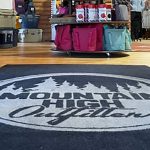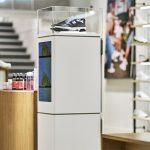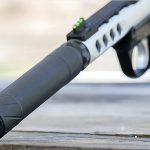Shares of The Sports Authority hit a new 52-week high last week as the new team of the recently merged entity laid out a bit of its vision for the only national sporting goods chain. Doug Morton, the CEO and vice chairman of the new company, was clearly in control of the analyst conference call on Wednesday that left little doubt that this deal was more of an acquisition by Gart rather than the merger of equals” that has been the party line since it was announced back in February.
The new company reported Q2 results for the Gart portion of the business only, stating that the quarter is a “lost quarter” for the former TSA business. Combined company results for the new Sports Authority will be provided beginning with the third quarter.
Marty Hanaka, chairman of the new merged company, was not on the call. Elliott Kerbis, president & chief merchant, and Tom Hendrickson, CFO and chief administrative officer, were on the call with Morton.
It was evident that Morton et al feel like this merger will be a much smoother transition than the Oshmans or Sportmart deal. The guys in Denver have perfected the merger and this one sees two companies that are pretty aligned strategically and operationally. The two retailers have been running similar systems and are now running in parallel, with a mid-September date targeted for full consolidation of computer operations.
While the call felt like a discussion of an acquisition in many respects, it was clear that the new team sees real opportunity for adopting “best practices”. Morton stressed that they all left their egos at the door and that nothing was out of bounds as they move to build an efficient operational model.
Management sees three key dates in their merger model. Obviously, August 4th was key as the date the deal was closed, but Morton stressed it was also a date that the team had to define “where are we?”. The next key date will be October 31st, the date set for all systematic and functional changes to be in place. The third date will be January 31, 2004, which management has set as the last date for any “real changes” to be made in the business.
New district management is already in place and cross-integrated. The company will be moving more than 140 people from the Ft. Lauderdale office to Denver, a bit short of the 250 or so they hoped would move.
Morton expects to see the majority of the buying group in place by the “second or third week of September”.
The other key initiative mentioned was the expansion of cold-weather product and equipment in TSAs Northeast and Midwest stores.
TSA lost out last year during the great winter in both areas, and will look to Garts expertise in winter sports to keep the right goods flowing this year.
Ski assortments will be increased in 56 stores, but will take a stepped in approach, with the team likening the mix to “older Gart stores”.
The company will also be ramping up the combined Private Label business, focusing efforts where each has been strongest. Kerbis said that the former TSA was getting “close to 10%” of its business in Private Label and were looking at 12% for the year. They have taken a step back a bit with the merger and are focused on getting the former Gart business close to the 10% level as well for2004.
On the discussion on vendors, Morton said they were comparing programs and productivity by vendor and category. Kerbis added that some “minor” changes will be made this year, but most will happen for the 2004 buying season.
It was clear that the former Gart folks saw the TSA model of a narrower SKU focus as a more productive model.
What doesnt seem to be working is some of the TSA stores. A total of 20 stores are slated for closure this year, including the last two smaller Gart mall-based formats. Eight stores will close the first week of September and the balance will close by the end of the year. The team cited financial reasons for five of those closures and the remainder due to overlap.
The company plans to replace the twenty stores in 2004, adding 870,000 square feet, a 5.3% increase. All stores opening this year are backfills in current markets, a strategy they see continuing for the near-term.
The new TSA will re-model 135 of the former TSAs stores, with 90 getting major re-fits. Seventy six of the re-models will happen in 2004.
Mr. Morton was “not sure” how the footwear departments will play out at the Sports Authority stores. TSA had been working to turn much of their self-service formats into full-service departments, a move that enabled them to get more Nike product, but hurt some other vendors. TSA had reported that the newer format stores were performing 400 basis points better than the self-service units. All full-service department personnel are on commission.
Morton said that some regions “may require service”.
The re-branding of stores will commence in late Q3 or early Q4, with Phoenix and St. Louis serving as the test markets for future roll-outs that should take “about two years” to complete.
Tom Hendrickson estimated that total merger costs would run $30 million to $45 million over the next twelve months. The company posted only $1.7 million in merger costs in the most recent quarter.
Doug Morton, the new CEO of the new The Sports Authority said that industry retail trends are mirroring consumer confidence trends as the company reported results for Gart Sports for the second quarter.
The company said that the first few weeks of August showed “flat” sales and expects to see flat comps with improving margins for the third quarter.
Moron said he sees an ongoing trend in gross margin improvement as the company boosted GM by 40 basis points in Q2, due mostly to better inventory control and merchandise management efforts. Inventory was down 2.3% on a per square foot basis.
Net income, when excluding one-time merger costs, was $6.3 million or $0.50 per fully diluted share, compared with $0.48 per fully diluted share in the prior year's quarter. Total sales increased 2.2% to $267.5 million and comparable store sales decreased 0.6% from the year-ago period on top of a 1.2% comp decline in Q2 2002.
The former Gart saw Games, Hunting, Camping Outdoor Apparel and Exercise in the positive territory for Q2, but saw negative comps in Inline Skates, Activewear and Athletic Footwear. Morton said footwear is “clearly better” so far in Q3, but that the Running category was “less than thrilling”. Tennis is soft and Classics is better, but not a big part of their business.
The reason for the positive mood going into the back half is that the better performing categories are a larger percentage of the business in H2. For instance, the poorly-performing Skate business is historically just 14% of sales in Q4, but makes up 22% of Q2 sales. Conversely, the stronger Exercise area is 11% of Q4 business, but just 7% in the second quarter. Morton also said they were up against a poor Q4 a year ago.
Third quarter comps were up 1.5% last year, but Q4 comps declined 3.5%. This year the combined comps are expected to be down -3% in Q3 and flat in Q4.
>>> Expectations are very high for this new company. Hopefully they can soon trade that positive mood for positive comps…















